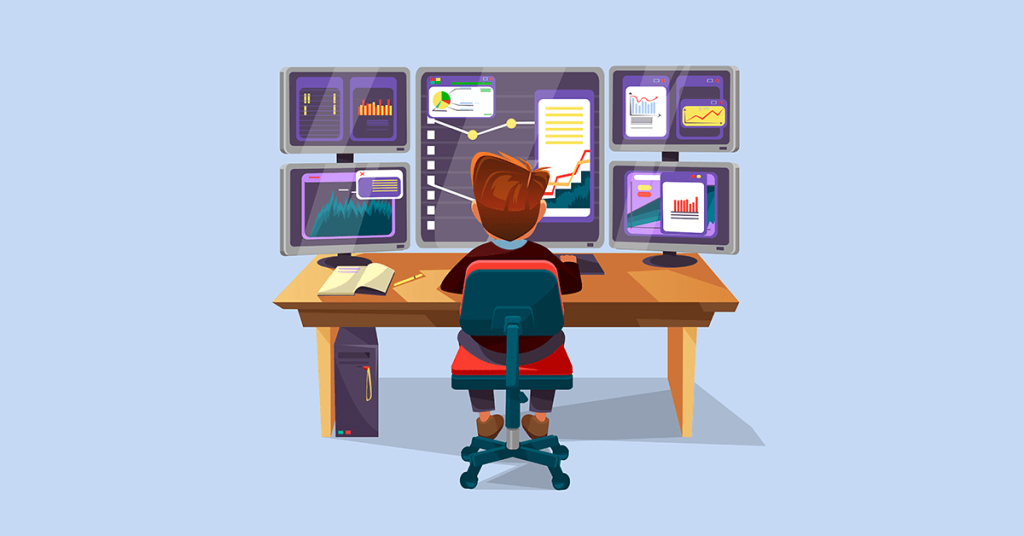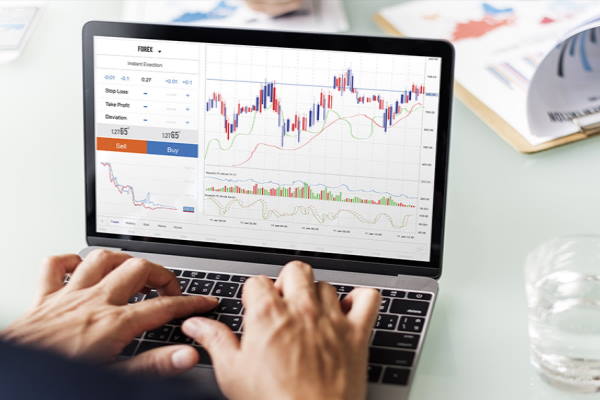What is trade and how to learn it?
The best getting started guide
Maybe you have heard a lot from your friends and family about the profits and losses they suffered in the financial markets. These people usually use the term trade for their activities in the financial markets. But what is trading, and how can you learn it? In this article from Ded9, in addition to answering this question, we discuss the types of trading and the stages of starting activities in the financial markets. Besides this, the types of financial markets and their positive and negative characteristics are discussed.
What is trade?
“Trade” is an economic concept that means buying and selling goods and services. There are two modes in the trading process. In the first case, the buyer receives the service or goods by paying the seller. The second case is when two parties exchange goods or services with each other. On a larger scale, producers and consumers can be introduced as two fixed members of the trade process.
In financial markets, traded assets are called “financial instruments.” These instruments include ” Stocks, “Bonds, “Currency Pairs,” “Options,” “Futures,” “Cryptocurrencies.”) and many other cases. Each of these tools can be traded in their own markets.
The term trade usually refers to short-term transactions. In these markets, traders operate actively and for short time periods. But this definition is not comprehensive and complete. The term trading includes many strategies, such as day trading, swing trading, etc. In the following, we will get to know the types of these strategies.
What is the investment?
“Investment” is the allocation of resources (such as capital) with the aim of generating profit. Therefore, investment can include providing the necessary resources to start a company or buying land to sell it for a profit. In financial markets, the concept of investment means involving assets in financial instruments to sell them at higher prices.

The amount of expected profit is a basic investment concept defined by the term ” return on investment ” (ROI). Compared to trading, investing is a more long-term approach to profit. The investor’s goal is to create wealth over a long period (years or even decades). There are many ways to invest. Investors usually discover suitable investment opportunities by using fundamental analysis.
Due to the long-term nature of this approach, investors usually do not involve themselves in short-term price fluctuations. For this reason, they act passively in the short term and do not worry about short-term losses.
What is the difference between investing and trading?
We answered the questions about trading and investment in the previous two sections. Now we want to examine the difference between these two concepts. Investors and traders both seek to generate profits in the financial markets. But the methods of achieving this profit are different in these two models.
In general, investors seek to earn profits over a long period of time. Therefore, according to this long time, the amount of profit they consider in each investment is a high amount. In contrast, traders seek to take advantage of market price fluctuations. They enter trading positions many times and exit them with some profit. Therefore, traders are not looking for a large profit per trade. The high number of transactions of traders can cause their capital to grow in the long term.
Now that the difference between these two methods has been explained, the question arises as to which method is better. You have to decide on this. It is better to learn about different financial markets and practice working in them. Over time and with experience, you will learn which method is most suitable for your financial goals, personality, and trading methods. In the continuation of this article from Faradars magazine, the characteristics of different markets are discussed. To get more information about traders and their activities in the financial markets, it is recommended to read the following article.
What is a trading tool?
Now that we have answered the question of what trading is and what investment is, it is time to examine trading tools. The meaning of trade tools is to introduce methods that can be used to find suitable trading positions. The two main tools used for this purpose are “Fundamental Analysis” and ” Technical Analysis. ”
Fundamental analysis in financial markets
Fundamental analysis is the trader’s first tool for entering trades. In fundamental analysis, the goal is to find the influencing parameters on the market and examine them. Therefore, to perform fundamental analysis, we need to be familiar with the basic concepts of that market. Fundamental analysis is a complex task requiring much knowledge and information.
For example, for the fundamental analysis of a listed company active in the field of steel, you need to be familiar with its processing methods, production costs, sales objectives, economic plans related to steel, etc. Also, for the fundamental analysis of digital currencies, in addition to economic knowledge, you need technical and computer knowledge to be able to check the relevant projects.
Since fundamental analysis is a difficult and complex process, it is usually done for long-term investments. If the fundamental analysis is done correctly, it can bring huge profits to the trader. A positive feature of fundamental analysis is that once the analysis is done, there is no need to check the market situation for a long time. The disadvantage of this method is its difficulty and its variability in different markets.

Technical analysis in financial markets
Technical analysis is the second tool that you can use to enter the financial markets. In technical analysis, it is assumed that the effect of all fundamental events on the price is included and can be seen in the price chart. Therefore, if it is possible to plan for its future from the price chart, there is no need to perform a fundamental analysis. The important advantage of technical analysis is that its basis is the same for all financial markets, and by learning it, you can analyze assets in different markets.
Over the past years, many people have tried to develop technical analysis. As a result of these efforts, various technical analysis tools and methods are available. Among these methods, we can mention trend lines, indicators, price action, classical patterns, and harmonic patterns, which we have already covered in Faradars magazine. Note that these tools are not necessarily all needed for market analysis, and you can analyze the market by finding your own suitable method.
Fundamental or technical analysis, which one is appropriate?
You should pay special attention to the following three issues to answer this question.
You should pay special attention to the following three issues to answer this question.
- Level of knowledge and literacy
- Trade type and trading strategy
- Personality characteristics
To use fundamental analysis in trading, you must choose a trading market with enough knowledge and literacy to analyze the parameters affecting it. In addition, to benefit from fundamental analysis, your trade type should be long-term so that you can examine all the influencing parameters. Since fundamental analysis requires a lot of time and energy, your personality should be such that you can spend high precision and concentration on analysis.
To use technical analysis in trading, you need relative familiarity with technical analysis tools and complete mastery of some of them. Learning technical analysis is much easier than fundamental analysis. Considering that technical analysis is used in all markets, you don’t need to be limited to one market. In technical analysis, you can choose the types of trade for your activity, which, of course, is determined by your trading tools and personality. To succeed in technical analysis, people need to have sufficient control over their personalities and emotions.
According to the materials mentioned, you can find your suitable analysis method. Most analysts usually use both analysis tools to enter the market.
What are the advantages and disadvantages of trade?
In particular, trading in each financial market has its advantages and disadvantages, which we discuss further in the market review section. Apart from that, there are generally advantages and disadvantages that can be considered for trade work. In fact, these features will make us decide whether or not trading is suitable for us. The following are considered to be the most important advantages of trading over other professions.
- The possibility of trading at different times and places
- The possibility of starting with low capital
- No special education required
- No need for expensive equipment
- High-profit potential
- The possibility of earning dollars
- The possibility of trading and earning profit in the short and long term
- Wide variety of markets and assets to trade
But trading also has disadvantages. Below are some of the most important trade disadvantages. Paying attention to these points at the beginning of the career path can be very useful.
- Psychological pressure resulting from market fluctuations
- Injuries caused by long-term computer work
- The possibility of big losses, which of course, can be avoided.
- The need for technical or fundamental analysis knowledge
- The need for planning and regularity, and continuous follow-up
- The need for continuous training and learning
Considering the mentioned advantages and disadvantages and your personality traits, you can determine whether trading is the right job for you. If trading is suitable for you, you can choose the right option for your trade by checking different markets.

What are the types of trade?
The question of what are the types of trade refers to the time of activity in the financial markets and the way of doing transactions. Some traders complete their day trades on the same day. At the same time, others may keep their deals open for months. In this section, we will examine the different methods of trading in the financial markets.
What is Day Trade?
“Day Trade” or “Day Trade” is the most famous method of active trading in financial markets. Some think that all traders active in the financial markets are among this category of traders. But this idea is completely wrong. Day trading involves entering and exiting a trading position on the same day. So in this method, traders seek to profit from price changes in a day.
The term day trading has its roots in traditional financial markets, where trades are open at a specific hour of the day. The stock markets of many countries are still active during the day for a limited time. Therefore, in these markets, day traders close all trading positions (positions) at the end of the market working hours and never start the next working day with an open position.
Many traders use the day trading method because things may happen after the market closes that will have a negative impact on the markets. If the trade is open for the next day, traders may incur irreparable losses.
Many new financial markets, such as the “ForEx” market and digital currencies, are active 24 hours a day. Especially the digital currency market, which is active 365 days a year and seven days a week. In such markets where there is no traditional trading time limit, the definition of day trading is different. In these markets, day trading means entering and exiting a trading position in less than 24 hours.
Traders usually use different methods of “technical analysis,” such as price action for daily trading. Since market volatility can be high during the day, day trading can bring huge profits or losses to traders. Therefore, this method is associated with risks and is not recommended for beginner traders.












